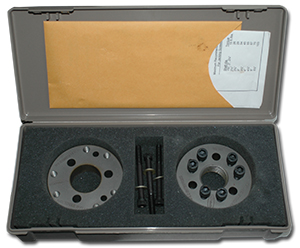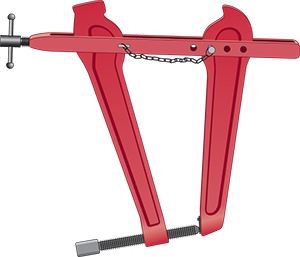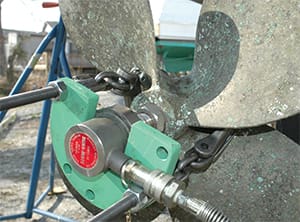Several years ago, as I was walking through a boatyard, I came across a mechanic who was in the process of removing a propeller. He was using a technique that, even when writing about it well over a decade later, makes me cringe. He’d removed the propeller’s nuts and in their place had installed what was later aptly referred to as a “bang nut,” an oversized closed-end brass nut. The bang nut was screwed onto the shaft; however, it stopped short of making contact with the propeller hub. Once the nut was installed, it was hammered on using a substantial maul.
As each blow connected with the bang nut, the shock wave was transmitted up the propeller shaft, through the coupling, into the transmission’s bearings and gears and onto the engine block, where it was ultimately absorbed by the flexible motor mounts. After a score of mighty swings, the mechanic was visibly fatigued and perspiring heavily, yet the propeller remained fast with the shaft. With each swing, the propeller reverberated with an ear-splitting twang. After a brief rest, he resumed and the propeller ultimately yielded, sliding aft into the nut with a clunk.
The physics of this approach are straightforward enough — with each blow, the shaft, transmission and engine were driven forward a fraction of an inch. The mass of the propeller encouraged it to be left behind in that forward advance, eventually forcing it to separate from the shaft taper. The technique worked, but at what price? It’s likely that removing a propeller using blunt force of this or any kind, including striking the forward end of the propeller hub directly and driving the propeller aft, damages or shortens the life of transmission components, gears, bearings, etc. Pound for pound, transmissions are among the most costly pieces of gear aboard your boat, and repairing or replacing them is always expensive. To be clear, this technique and others of a blunt-force nature should never be employed for propeller removal.
 |
|
For those wishing to carry their own means of propeller removal, the PropSmith is compact and efficient. |
|
Steve D’Antonio |
Removal options
For boatyards, the Cadillac of propeller removal tools relies on the power and compactness of hydraulics. Combination tool kits are available to remove propellers, shaft couplings and strut-mounted bearings. These tools enable yards to quickly and easily disassemble these components using a hand-operated hydraulic pump that actuates a ram, which in turn applies thousands of pounds of continuous — rather than shock — force to an assembly without stressing the transmission. If you are in need of propeller service or shaft coupling removal, it’s well worth finding a yard that relies on the kinder, gentler tool of this sort.
It’s worth repeating that under no circumstances should it ever be necessary to use shock force to disassemble any of the aforementioned components, propellers, couplings and shaft bearings. As you might imagine, the convenience of this tool comes at a price. A combination hydraulic prop, coupling and shaft bearing removal tool costs several thousand dollars, and it’s large and heavy. In most cases, it’s housed in a rolling dolly that’s about the size of a baby stroller.
Alternatively, mechanical scissor-like prop removal tools are also available. These are comparatively compact, lightweight and much less expensive. While useful, these tools do have limitations. Primarily, they are incapable of imparting as much force as a hydraulic tool, and they must be able to “reach” between two adjacent propeller blades, a requirement that may not be possible with some four-blade and most five-blade propellers.
Yet another option relies on a custom-made yet exceedingly simple pulling mandrel. This arrangement consists of three high-strength threaded rods and a plate that uses the propeller shaft end as its fulcrum. The rods are screwed into matching threaded holes that have been bored and tapped in the aft end of the propeller hub. Some propellers come from their manufacturer with these holes (if you are ordering a new prop or new boat, request them); some include just two holes, which, while better than nothing, I would argue is inadequate for this process; and some propellers have no holes. In any event, the holes can be easily added by most propeller shops. However, this cannot be done while the propeller is installed on the shaft.
 |
|
The “scissors” style tool is effective and inexpensive. However, it cannot be used on props with overlapping blades. |
A custom tool
With careful measurement and a drawing or wood template, most machine shops could make a custom tool at relatively low cost (I would argue that these should be provided as an option or standard by every boatbuilder for their particular propeller arrangement). The plate need not be made from exotic alloys; ordinary mild steel is more than adequate, provided it’s painted and lightly oiled. The threaded rods or bolts should be high strength, and these can be easily purchased off the shelf.
The final approach relies on a method that bears some resemblance to the pulling mandrel, but it uses a purpose-made tool known as a PropSmith. The PropSmith also requires a trio of threaded holes in the prop’s hub; however, its fulcrum plate engages the shaft’s threads, holding it rock steady and making it especially useful for in-water use by a diver. Because of this threaded shaft engagement, an added benefit of the PropSmith is its ability to aid in the installation of a propeller, pushing it firmly onto the taper. Not only is this tool effective, but even models for large props are compact, taking up no more room than two hardcover books.
It’s not unreasonable to suggest that every vessel carry its own means of propeller removal, even if you never intend to undertake this task yourself. If you find yourself in a boatyard for planned or unexpected propeller work and you see a mechanic making his or her way toward your boat carrying a large hammer, you can intercede with your own tool, knowing it will work well and it will work quickly, and confident it won’t cause any damage in the process.
Steve D’Antonio is a marine systems consultant, seminar instructor, writer, photographer and ABYC master technician (stevedmarineconsulting.com).

